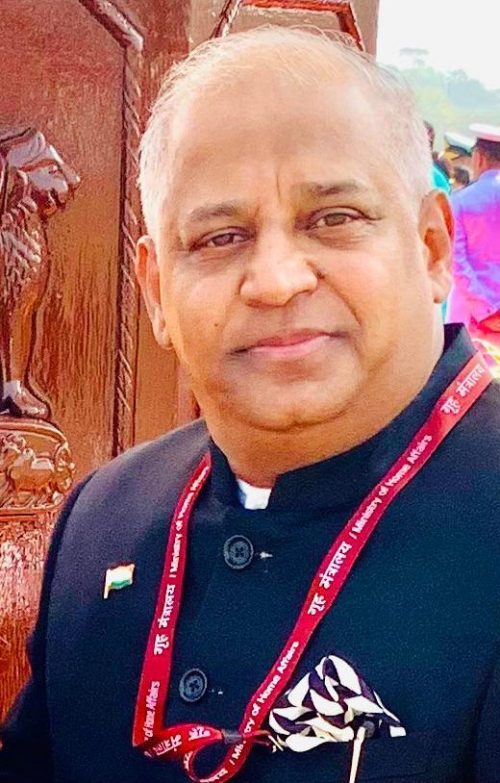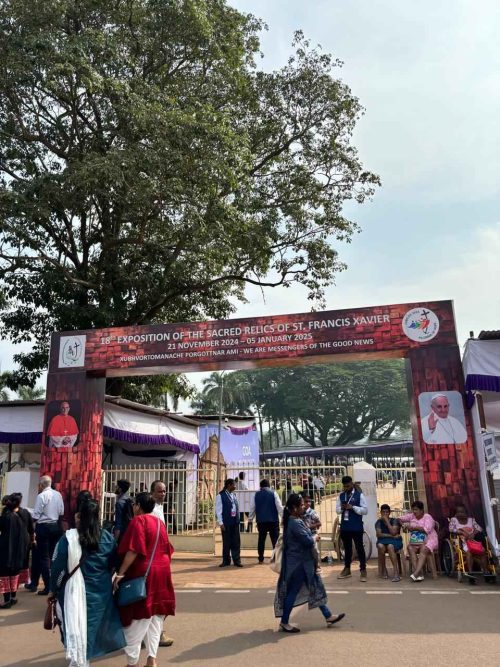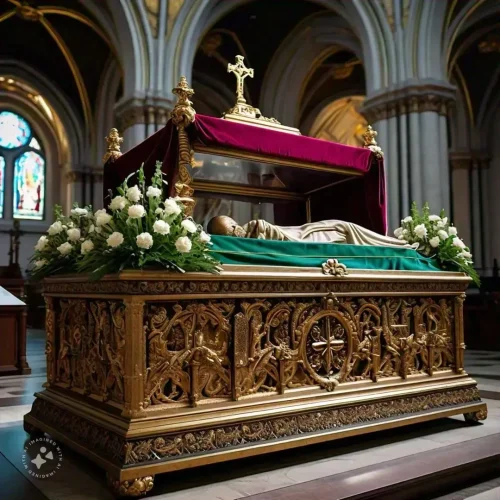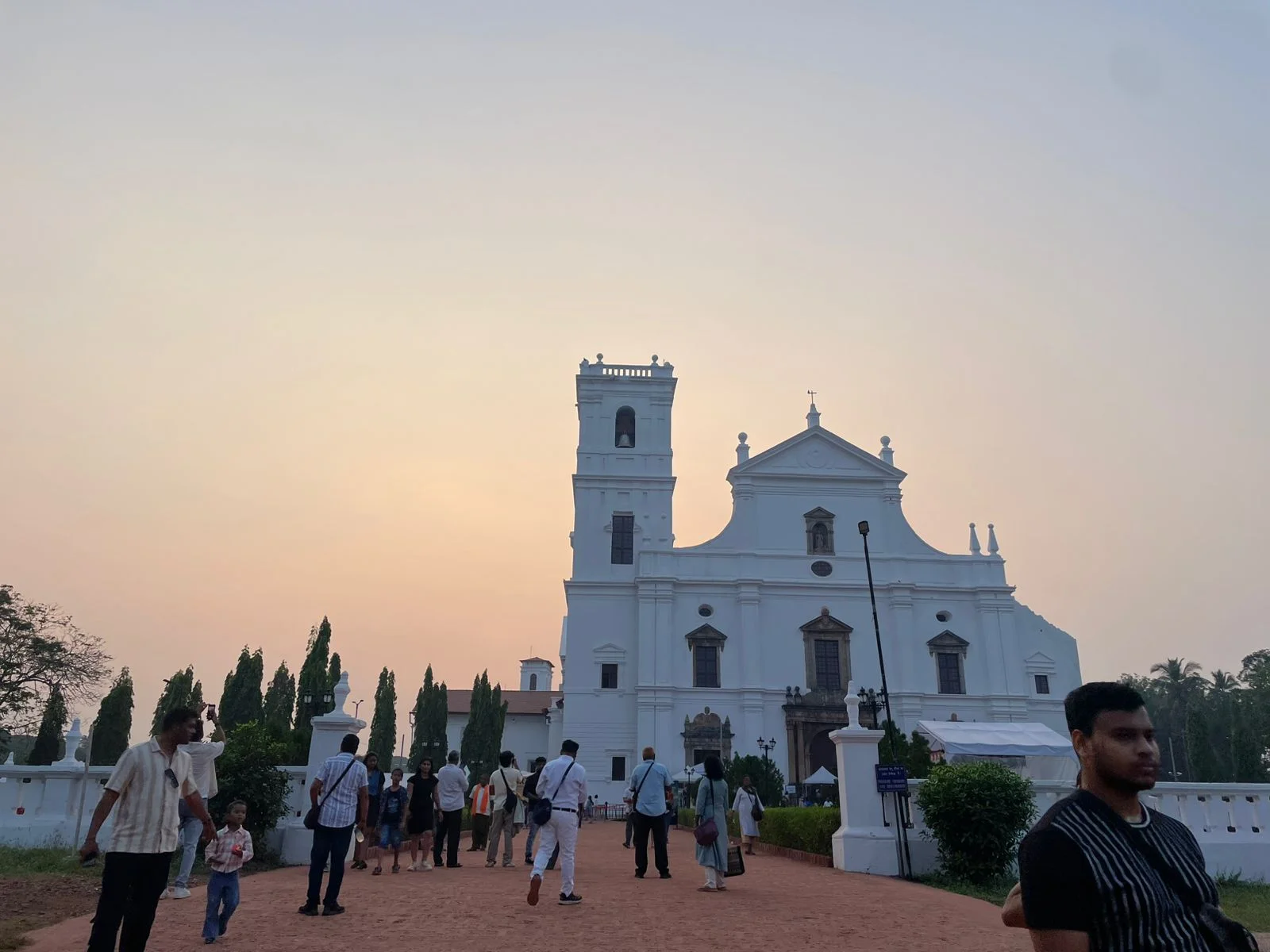“Despite the massive crowd on a Sunday, the queue moved with efficiency and decorum,” says Jessica Annie Singh, a 25-year-old visitor who made her way through the crowd at the Se Cathedral in Old Goa. Amidst the sea of devotees, what caught her attention was the coordination that made navigating the crowd feel well-ordered.
Her feelings reflect those of many who attended the St. Francis Xavier Exposition 2024-2025.
The seamless execution of the grand event was led by Sandip Jacques (53), a seasoned IAS officer and Goa’s Commissioner and Secretary of Revenue and Law. As the Commissioner for the Exposition, he ensured smooth operations and coordination across departments.
Born into a family with a strong medical background, Sandip initially pursued a master’s degree in medical microbiology. However, after a shift in interests, he began studying law until his father-in-law, a police officer, encouraged him to consider the civil services. His suggestion to attempt the civil service exams ultimately changed the course of Sandip’s life.
From medical to civil services
“I was more inclined towards law at the time, but my father-in-law encouraged me to try the civil services during my final year,” he tells The Better India. By 1997, at just 24, Sandip had passed the exams and joined the Goa Civil Services. His journey from there eventually led him to the Indian Administrative Service (IAS), with postings in Andaman, Delhi, and now Goa.

Before entering public administration, he was an accomplished sportsman, competing in football, hockey, and table tennis at the state and national levels. “Sports and education should go hand in hand,” he reflects. “They teach you discipline, teamwork, and resilience qualities that have been essential in my career.”
When the IAS officer was tasked with managing the St Francis Xavier Exposition, he knew he had to devise innovative strategies and approaches. Held once every ten years, the event attracts millions of devotees and tourists to Goa to witness the veneration of the saint’s relics at the Se Cathedral. The 2024-2025 exposition, which ran from November 21 to January 5, drew a record-breaking eight million visitors.
Preparing for millions: The team behind the exposition
Jessica drew a picture of the meticulous planning that went into the event. “The security arrangements were top-notch,” she says. “Baggage scanners, frisking, designated entry and exit points, clear signage, and a significant police presence ensured that every individual was thoroughly screened before entering the Se Cathedral.”
To handle an event of this scale, Sandip broke the work down into nine key areas, ensuring each was managed by an expert. “The success of any large-scale event lies in the collective effort of a team,” he explains.
Security and crowd management
With thousands of visitors expected, maintaining order was critical. The Inspector General of Police oversaw traffic and security, ensuring the crowds moved safely and efficiently. Meanwhile, the Collector of North Goa handled administration and protocol, acting as the bridge between government authorities and church officials.

Infrastructure and cleanliness
The venue had to be well-prepared. The Chief Engineer of the PWD ensured all facilities were in place, while the Commissioner of Labour and Employment managed waste management and sanitation to keep the grounds clean and organised.
Communication and budgeting
Keeping the public informed was crucial, and the Director of Information and Publicity took charge of media and communication. Finances were just as important, and the Additional Secretary of the Finance Department ensured the event stayed within budget. “We had to make sure resources were allocated efficiently, and we succeeded in doing that,” Sandip says.
Health, IT and emergency preparedness
From IT and accreditation to medical facilities, every detail was covered. The Managing Director of ITG handled tech needs, while the Director of Health Services ensured medical teams were ready for any emergencies. A senior PWD officer managed transport and disaster preparedness, ensuring everything was in place for a safe event.
“By having the right people in place and trusting their expertise, we ensured that no aspect of the Exposition was overlooked,” Sandip adds.
Managing crowd surges through quick decisions
Crowd management posed its fair share of challenges, particularly when the visitor numbers surged. On weekends and holidays, the crowds became overwhelming, and quick action was the need of the hour to avoid mishaps.

“Sometimes, you need to make decisions on the fly,” Sandip admits. “When the crowd swells, you must adjust to ensure safety and ease of movement. We had to extend veneration timings on some days or halt certain services temporarily to give the crowd time to disperse.”
His ability to adapt on the spot was key to managing these challenges. For instance, to reduce the strain of long walks on elderly visitors and to help people with disabilities, he introduced buggies and e-rickshaws to transport people from the parking areas to the veneration site.
However, when the crowds became too large, sometimes these services were paused for a certain period. “You need to be flexible and make on-the-spot decisions to avoid casualties during these situations,” he says.
With millions of visitors, the potential for stampedes was a concern. “Discipline and clear protocols are critical,” the IAS officer stresses. The veneration queues were carefully monitored by civil authorities and the police to prevent overcrowding. His team ensured that the queues were well-regulated, spreading out veneration times across the day to avoid bottlenecks.
Jessica recalls, “Despite the overwhelming crowds, everything felt controlled, and we didn’t feel claustrophobic. The volunteers guided us, and there was a clear system in place that everyone followed.”
‘We set up control rooms that monitored the crowd movement’
To further ensure safety, Sandip’s team made use of technology. “We set up control rooms that monitored the crowd movement using AI-based technology to count people in real-time,” he explains. This technological assistance allowed the team to adjust their plans as needed, keeping the event under control at all times.

One of the key factors behind the success of the Exposition was the collaboration between the Goa government and the church. “It wasn’t just a government-managed event, it was a joint effort with the church,” he reflects. This partnership ensured that all aspects of the Exposition, from the religious ceremonies to crowd management, were handled with care and respect for the cultural and spiritual significance of the event.
Sandip credits the success of the Exposition to the strength of the team behind it. “It’s not a one-person job,” he says. “You need a team of dedicated professionals who can take charge of their respective areas and work together towards a common goal.”
Experience with large-scale events
This was not the first time the IAS officer was tasked with managing a large-scale event. In 2013-14, as the Executive Director of the Sports Authority of Goa, he was given the responsibility of overseeing the Lusofonia Games, a multi-sport event for Portuguese-speaking nations. “Organising an event of such magnitude is always a challenge. But with the right team and resources, it becomes a rewarding experience,” he says.
The Lusofonia Games, which brought together countries like Brazil, Portugal, and Zimbabwe, could be likened to a mini-Olympics held in the State of Goa. The event was especially significant due to Goa’s historical ties with the Portuguese regime, as it was once part of the Portuguese empire, and many people in the region speak Portuguese.

As the Vice Chairman of the Lusofonia Games Organising Committee (LUGOC), he had the task of coordinating between various sports federations and the local government to ensure the event’s success. “We had to manage the logistics carefully, ensuring that all facilities were ready in time for the Games,” he adds
“We were tasked with overseeing the construction of entirely new stadiums, as well as refurbishing the existing ones. Given the limited time we had, it was a challenging endeavour, but we managed to complete everything within the deadlines. Our team of IAS officers worked relentlessly, ensuring all facilities were up to standard, and we were ultimately able to deliver the Lusofonia Games successfully in 2013-14,” he explains.
This experience in managing high-pressure events gave him the skills and insight necessary to handle the complexities of the St Francis Xavier Exposition in 2024. Managing large-scale public events is no small feat. The officer’s approach to the St Francis Xavier Exposition demonstrates that thorough planning, quick decision-making, and teamwork are the backbone for carrying out any event.
Edited by Megha Chowdhury; All pictures courtesy Sandip Jacques and Jessica Annie Singh
No comments:
Post a Comment